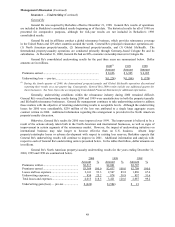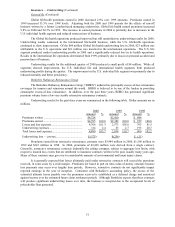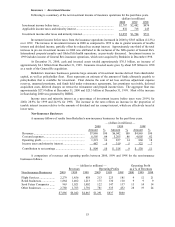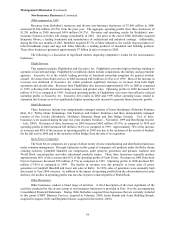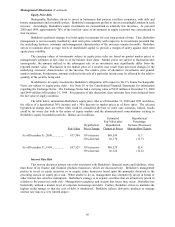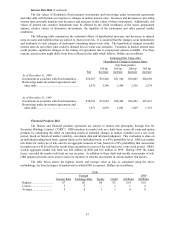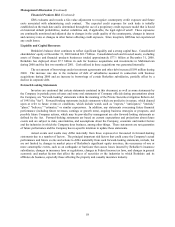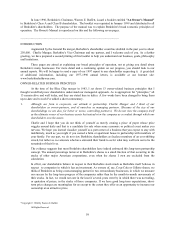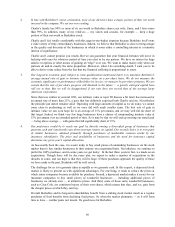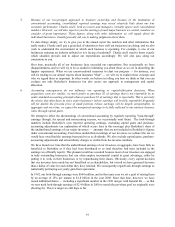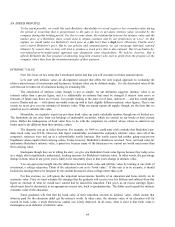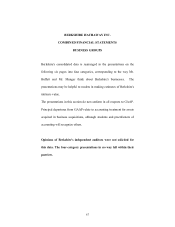Berkshire Hathaway 2000 Annual Report Download - page 59
Download and view the complete annual report
Please find page 59 of the 2000 Berkshire Hathaway annual report below. You can navigate through the pages in the report by either clicking on the pages listed below, or by using the keyword search tool below to find specific information within the annual report.58
Management's Discussion (Continued)
Financial Products Risk (Continued)
GRS evaluates and records a fair-value adjustment to recognize counterparty credit exposure and future
costs associated with administering each contract. The expected credit exposure for each trade is initially
established on the trade date and is determined through the use of a proprietary credit exposure model that is based
on historical default probabilities, market volatilities and, if applicable, the legal right of setoff. These exposures
are continually monitored and adjusted due to changes in the credit quality of the counterparty, changes in interest
and currency rates or changes in other factors affecting credit exposure. Since inception, GRS has not experienced
any credit losses.
Liquidity and Capital Resources
Berkshire's balance sheet continues to reflect significant liquidity and a strong capital base. Consolidated
shareholders' equity at December 31, 2000 totaled $61.7 billion. Consolidated cash and invested assets, excluding
assets of finance and financial products businesses totaled approximately $77.1 billion at December 31, 2000.
Berkshire has deployed about $7.7 billion in cash for business acquisitions and investments in MidAmerican
during 2000 and the first two months of 2001. Cash utilized in these acquisitions was generated internally.
The net amount of borrowings under investment agreements and other debt increased $198 million during
2000. The increase was due to the inclusion of debt of subsidiaries assumed in connection with business
acquisitions during 2000 and an increase in borrowings of certain Berkshire subsidiaries, partially offset by a
decline in corporate debt.
Forward-Looking Statements
Investors are cautioned that certain statements contained in this document, as well as some statements by
the Company in periodic press releases and some oral statements of Company officials during presentations about
the Company, are "forward-looking" statements within the meaning of the Private Securities Litigation Reform Act
of 1995 (the "Act"). Forward-looking statements include statements which are predictive in nature, which depend
upon or refer to future events or conditions, which include words such as "expects," "anticipates," "intends,"
"plans," "believes," "estimates," or similar expressions. In addition, any statements concerning future financial
performance (including future revenues, earnings or growth rates), ongoing business strategies or prospects, and
possible future Company actions, which may be provided by management are also forward-looking statements as
defined by the Act. Forward-looking statements are based on current expectations and projections about future
events and are subject to risks, uncertainties, and assumptions about the Company, economic and market factors
and the industries in which the Company does business, among other things. These statements are not guaranties
of future performance and the Company has no specific intention to update these statements.
Actual events and results may differ materially from those expressed or forecasted in forward-looking
statements due to a number of factors. The principal important risk factors that could cause the Company's actual
performance and future events and actions to differ materially from such forward-looking statements, include, but
are not limited to, changes in market prices of Berkshire's significant equity investees, the occurrence of one or
more catastrophic events, such as an earthquake or hurricane that causes losses insured by Berkshire's insurance
subsidiaries, changes in insurance laws or regulations, changes in Federal income tax laws, and changes in general
economic and market factors that affect the prices of securities or the industries in which Berkshire and its
affiliates do business, especially those affecting the property and casualty insurance industry.


